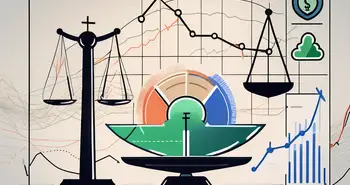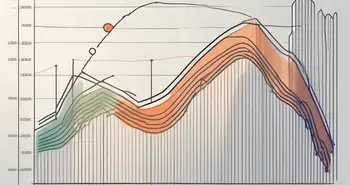Understanding the Importance of Value at Risk in Financial Risk Management

As a financial risk management expert, I cannot stress enough the importance of understanding and effectively utilizing Value at Risk (VaR). VaR is a vital tool that enables investors and financial institutions to assess and manage potential risks associated with their investment portfolios. By quantifying the potential loss within a specific time frame, VaR aids in making informed decisions, optimizing portfolios, and safeguarding against unforeseen events.
Defining Value at Risk (VaR)
To comprehend the significance of VaR, it is crucial to first understand its definition. VaR is a statistical measure used to estimate the maximum potential loss an investment portfolio or financial institution may face within a given time frame and at a certain level of confidence. In simpler terms, VaR helps answer the critical question: “What is the maximum amount of money I can potentially lose on this investment, and how likely is it to occur?”
The Concept of VaR
VaR operates on the principle that financial markets can experience fluctuations and that there is always an associated level of risk involved in investments. By quantifying this risk, VaR offers investors and risk managers a powerful metric for evaluating and comparing different investment options. It provides a standardized approach to assess the potential downside, facilitating the identification of riskier investments or portfolios that require additional risk mitigation strategies.
Key Components of VaR
There are three essential components that form the foundation of VaR calculations: time frame, probability level, and historical data. The time frame establishes the period over which the VaR is calculated, such as daily, weekly, or monthly. The probability level determines the confidence level associated with the VaR estimate – for example, a 95% confidence level implies that there is a 5% chance of exceeding the VaR. Lastly, historical data, especially past price movements or returns, helps in estimating the potential losses that an investment portfolio may encounter.
Let's delve deeper into each of these key components. The time frame chosen for VaR calculations is a critical decision that depends on various factors, including the investment horizon, market volatility, and the desired level of precision. For short-term investments, a daily or weekly time frame may be suitable, while long-term investments may require a monthly or even quarterly time frame. The choice of time frame should align with the investment strategy and the level of risk tolerance of the investor or financial institution.
The probability level is another crucial aspect of VaR calculations. It represents the level of confidence associated with the VaR estimate. A higher probability level, such as 99%, implies a higher level of confidence in the VaR estimate, but it also means a higher potential loss threshold. On the other hand, a lower probability level, such as 90%, may provide a more conservative estimate but with a lower potential loss threshold. The selection of the probability level should consider the risk appetite and risk management policies of the investor or financial institution.
The Role of VaR in Financial Risk Management
VaR plays a vital role in financial risk management by providing a comprehensive understanding of potential risks and aiding decision-making processes. Let's explore two significant aspects of how VaR contributes to effective risk management: risk assessment and decision making.
Risk Assessment and VaR
VaR serves as a valuable tool for assessing the risk profile of an investment portfolio. By evaluating the potential downside, risk managers can identify and analyze areas of vulnerability. This allows for the formulation and implementation of risk mitigation strategies, such as diversification or hedging, to protect against adverse market conditions. Furthermore, the ability to quantify risks through VaR helps investors set risk tolerance levels and allocate resources accordingly.
VaR in Decision Making
The use of VaR as a decision-making tool is becoming increasingly prevalent within the financial industry. By considering VaR estimates, investment managers can evaluate different strategies and make informed choices based on their risk appetite. For example, VaR calculations can assist in determining the optimal allocation of capital across asset classes, identifying potential asset or investment value limits, and even aiding in the development of market entry or exit strategies.
Advantages of Using VaR in Financial Risk Management
VaR offers several noteworthy advantages that contribute to its wide adoption in financial risk management practices. Let's delve into two key advantages: quantifying market risk and optimizing portfolios.
Quantifying Market Risk with VaR
One of the primary advantages of VaR is its ability to quantify market risk accurately. By analyzing historical data, market fluctuations, and portfolio compositions, VaR calculations provide risk managers with a clear understanding of potential losses during normal market conditions. This enables them to proactively anticipate and address potential risks, minimizing adverse impacts on their investment portfolios.
Portfolio Optimization and VaR
Optimizing investment portfolios is a crucial objective for any investor or financial institution. VaR can play a pivotal role in achieving this objective by providing valuable insights into portfolio performance and potential downside risks. Risk managers can use VaR calculations to identify the optimal balance between risk and return, strategically allocating assets across different investment avenues. By curating diverse portfolios with favorable risk-reward profiles, investors can maximize returns while minimizing exposure to potential losses.
Limitations of VaR in Financial Risk Management
While VaR is undoubtedly a powerful tool, it is essential to acknowledge its limitations and potential challenges. Let's explore two significant limitations and discuss ways to overcome them.
Assumptions and Criticisms of VaR
One common criticism of VaR is that it relies on certain assumptions, which may not always hold true in real-world scenarios. For instance, VaR calculations typically assume that historical patterns will repeat, discounting the possibility of sudden market disruptions or unprecedented events. Moreover, it is important to note that VaR estimates provide a quantitative aspect of risk but do not consider qualitative factors that may impact the overall risk profile. Despite these limitations, VaR remains a useful risk management tool when complemented with other risk assessment methods and stress tests.
Overcoming VaR Limitations
To overcome the limitations of VaR, it is vital to adopt a holistic approach to risk management. By combining VaR with other risk management tools, such as stress tests and scenario analyses, investors can develop a more comprehensive understanding of potential risks and their impact. Additionally, considering qualitative factors, market awareness, and staying informed about industry trends can further enhance the effectiveness of VaR in managing financial risks.
Future of VaR in Financial Risk Management
The evolution of financial markets and technological advancements are reshaping the role of VaR in financial risk management. Here, we discuss two critical factors influencing the future of VaR.
Technological Advancements and VaR
Rapid technological advancements are revolutionizing financial risk management practices. With the advent of sophisticated algorithms, machine learning, and artificial intelligence, risk managers can process vast amounts of data quickly and accurately. These advancements enable more efficient and precise VaR calculations, enhancing risk prediction capabilities and aiding in decision-making processes.
Evolving Financial Markets and VaR
Financial markets are constantly evolving, with new investment products and trading strategies emerging. As a result, VaR methodologies and calculations need to adapt to these dynamic market conditions. Risk managers must remain vigilant and continuously update their VaR models to account for novel risks and market developments. This adaptability ensures that VaR remains relevant and effective in managing financial risks in an ever-changing landscape.
FAQs – Revisiting the Main Points
What is VaR, and why is it important?
VaR, or Value at Risk, is a statistical measure that quantifies potential losses in an investment portfolio within a given timeframe and at a specific level of confidence. It is crucial because it helps investors and financial institutions understand and manage potential risks effectively.
How does VaR contribute to risk assessment?
VaR aids risk assessment by providing a standardized approach to measure and compare potential risks associated with investment portfolios. It helps identify areas of vulnerability and assists in formulating risk mitigation strategies.
What are some advantages of using VaR in financial risk management?
VaR offers advantages such as accurately quantifying market risk and optimizing investment portfolios. It enables risk managers to anticipate and address potential risks, enhance decision-making processes, and maximize returns while minimizing exposure to losses.
What are the limitations of VaR?
VaR relies on certain assumptions that may not always hold true in real-world scenarios. It also fails to consider qualitative factors that may impact the overall risk profile. Therefore, it is vital to complement VaR with other risk assessment methods and stay informed about market trends to mitigate these limitations effectively.
How is the future of VaR shaped by technological advancements and evolving financial markets?
Technological advancements, such as algorithms and artificial intelligence, enhance the precision and efficiency of VaR calculations. Meanwhile, evolving financial markets necessitate constant updates to VaR models to account for novel risks and changing market conditions.
In conclusion, understanding the importance of Value at Risk in financial risk management is essential for investors and financial institutions seeking to protect their portfolios and make informed decisions. By comprehending the concept of VaR, acknowledging its limitations, and leveraging its advantages, risk managers can effectively assess and manage potential risks. As the future unfolds, embracing technological advancements and adapting VaR models to evolving financial markets further enhances the effectiveness of this crucial risk management tool.
As you navigate the complexities of financial risk management and leverage the insights provided by Value at Risk, consider the innovative solutions offered by Morpher. Embrace a trading platform that not only understands the importance of effective risk assessment but also provides a revolutionary approach to investing. With Morpher's zero fees, infinite liquidity, fractional investing, and unique trading experience, you're equipped to make informed decisions that align with your financial goals. Take control of your investments with the safety and flexibility of Morpher's blockchain technology. Sign Up and Get Your Free Sign Up Bonus today, and transform the way you trade across various asset classes.

Disclaimer: All investments involve risk, and the past performance of a security, industry, sector, market, financial product, trading strategy, or individual’s trading does not guarantee future results or returns. Investors are fully responsible for any investment decisions they make. Such decisions should be based solely on an evaluation of their financial circumstances, investment objectives, risk tolerance, and liquidity needs. This post does not constitute investment advice.

Painless trading for everyone
Hundreds of markets all in one place - Apple, Bitcoin, Gold, Watches, NFTs, Sneakers and so much more.

Painless trading for everyone
Hundreds of markets all in one place - Apple, Bitcoin, Gold, Watches, NFTs, Sneakers and so much more.









